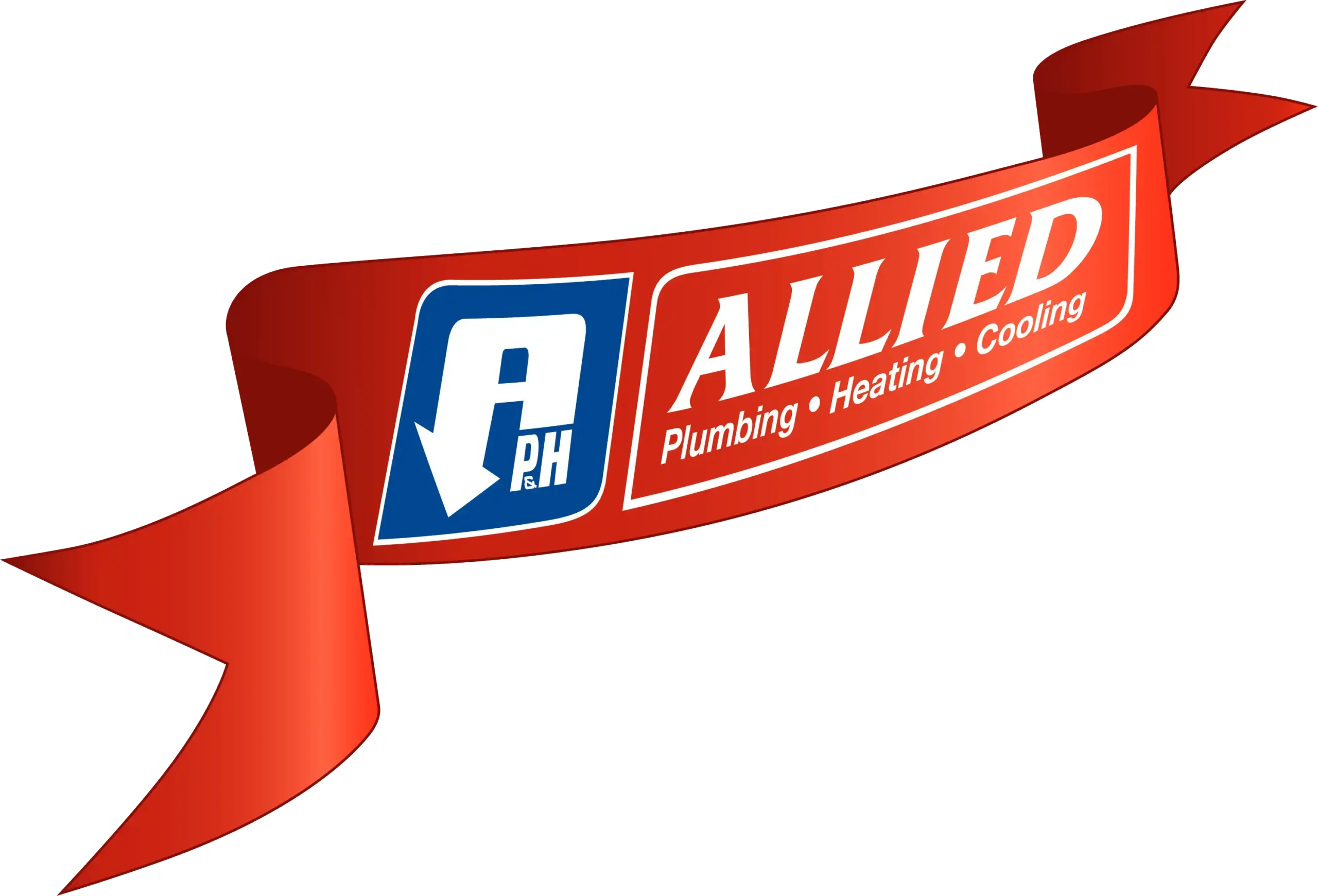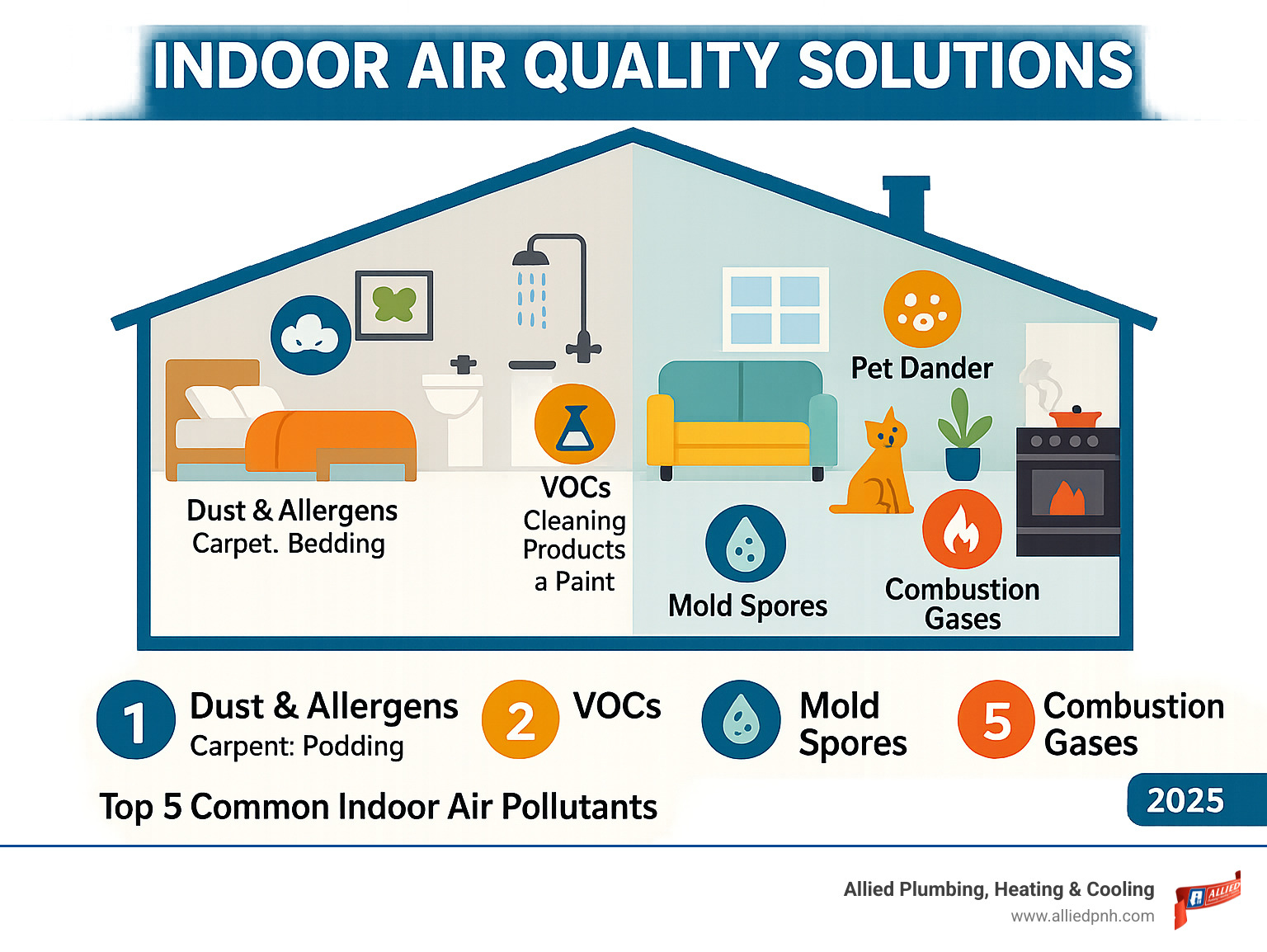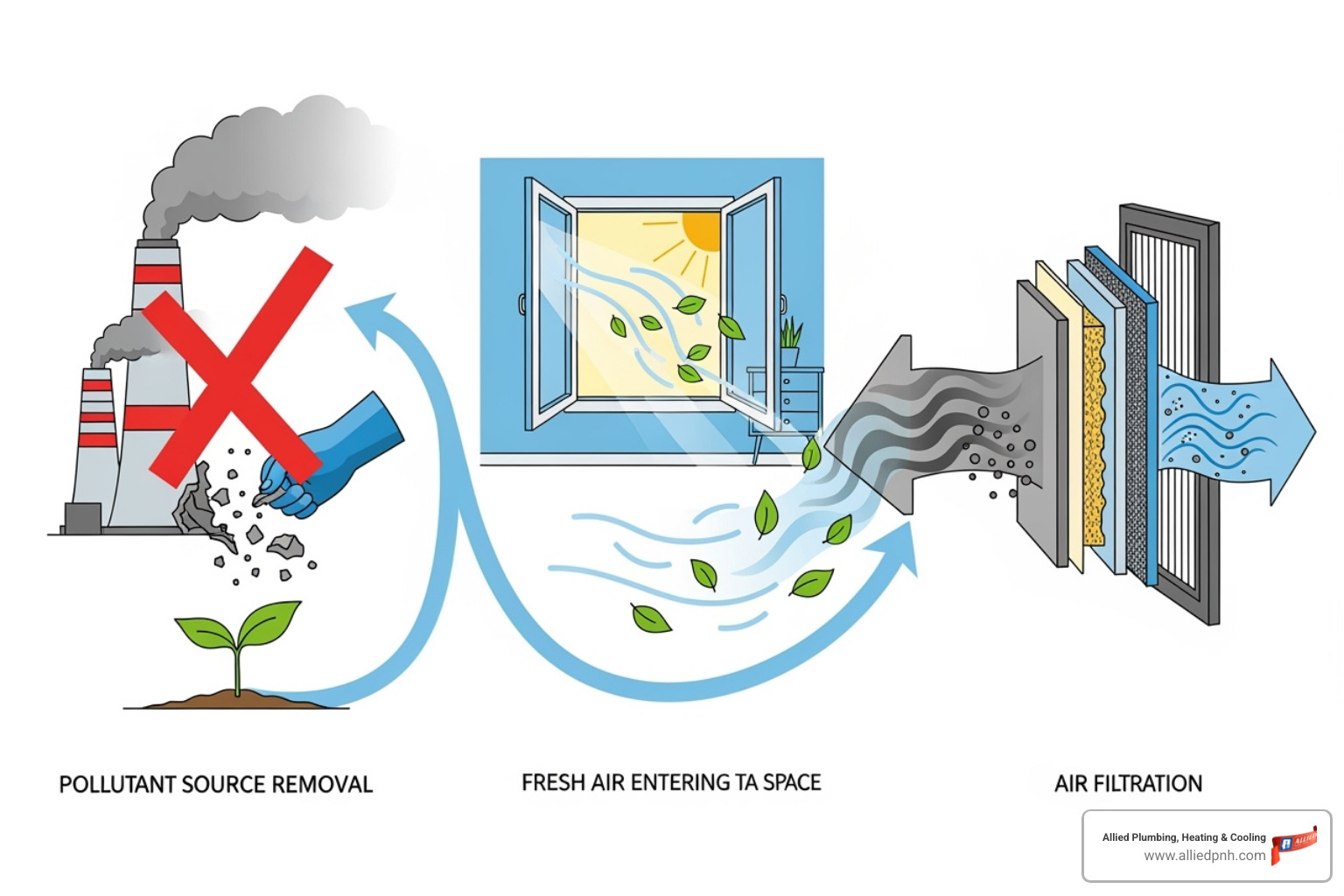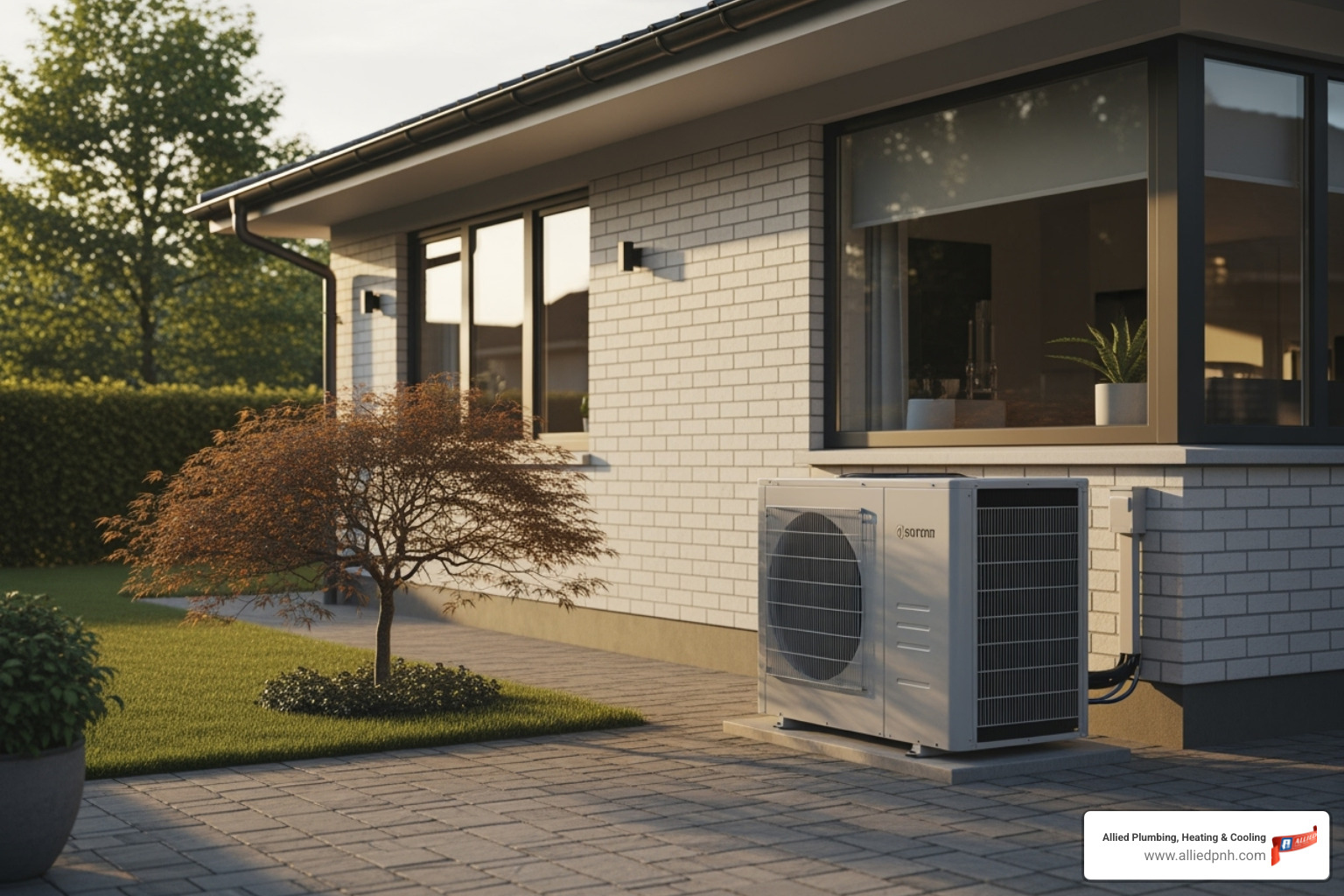Why Indoor Air Quality Solutions Can Transform Your Home’s Health
Indoor air quality solutions are essential for creating a healthier home environment. The air inside your home can contain pollutants at concentrations 2-5 times higher than outdoor air, according to EPA studies. Here are the most effective approaches to improve your indoor air:
Top Indoor Air Quality Solutions:
- Source Control – Remove or reduce pollution sources like VOCs from cleaning products
- Improved Ventilation – Increase fresh air circulation with exhaust fans and HVAC systems
- Air Filtration – Install HEPA filters and air purifiers to capture particles
- Humidity Control – Maintain 30-60% humidity with humidifiers/dehumidifiers
- Professional HVAC Maintenance – Regular system cleaning and filter replacement
The EPA consistently ranks indoor air pollution among the top 5 environmental risks to public health. Yet most Springfield homeowners spend 90% of their time indoors, breathing air that may contain harmful pollutants like dust, pet dander, mold spores, and volatile organic compounds (VOCs).
The good news? Simple, proven solutions can dramatically improve your home’s air quality. Whether you’re dealing with allergies, musty odors, or just want peace of mind about your family’s health, the right combination of strategies can make your home’s air cleaner and healthier to breathe.
Why Indoor Air Quality Matters More Than You Think
Picture this: you step outside on a smoggy day and immediately think about air pollution. But here’s the surprising truth – the air inside your home is likely 2-5 times more polluted than the air outside. Sometimes it’s even worse, with concentrations reaching up to 10 times higher indoors.
This isn’t just a minor inconvenience. Poor indoor air quality affects every aspect of your daily life, from your health and comfort to your productivity and even your home’s HVAC equipment.
Common Culprits: Identifying Sources of Indoor Pollution
The pollutants floating around your Springfield home come from sources you interact with every single day. Understanding where they originate is the first step toward effective indoor air quality solutions.
Building materials and furniture are often the silent offenders. That new carpet, fresh paint, or even your kitchen cabinets can release volatile organic compounds (VOCs) like formaldehyde into the air. These invisible gases are especially problematic when items are new, but they can continue off-gassing for months or even years.
Your household products are another major contributor. Every time you spray that bathroom cleaner, use an air freshener, or apply nail polish, you’re releasing chemicals into your home’s air. Even products marketed as “natural” can contain VOCs that affect your indoor environment.
Combustion appliances like your gas stove, fireplace, or furnace can be particularly dangerous if they’re not properly maintained. These appliances can release carbon monoxide – a colorless, odorless gas that’s potentially deadly. Without proper ventilation, these invisible fumes can build up to dangerous levels.
Your furry friends and the hidden critters in your home contribute too. Pet dander floats through the air long after your dog or cat has left the room. Dust mites thrive in bedding, upholstery, and carpets, while mold and mildew love damp basements, bathrooms, and poorly ventilated areas.
Even the outdoor air that enters your home can bring problems inside. Pollen during allergy season, wildfire smoke, and pollution from nearby roads all find their way into your living space through open windows, doors, and small cracks.
Tobacco smoke lingers long after cigarettes are extinguished, and radon – a naturally occurring radioactive gas – can seep up through your foundation from the soil below.
The Hidden Toll: Health, Comfort, and Productivity Impacts
Poor indoor air quality doesn’t just make your home feel stuffy. It can seriously impact your family’s health, comfort, and daily performance in ways you might not even realize.
Health problems are the most concerning consequence. If anyone in your family suffers from allergies or asthma, poor air quality can trigger attacks and make symptoms much worse. You might notice more frequent headaches, fatigue, or respiratory issues that seem to improve when you leave the house.
Carbon monoxide exposure is especially dangerous because you can’t see, smell, or taste it. Early symptoms like dizziness and nausea are often mistaken for the flu, but prolonged exposure can lead to serious organ damage or even death.
The long-term health risks are equally serious. Scientific research shows that chronic exposure to certain indoor pollutants increases your risk of heart disease, kidney problems, and some types of cancer.
But it’s not just about major health scares. Poor air quality affects your daily comfort and productivity too. When humidity levels are off, you might deal with dry, itchy skin, irritated sinuses, or that uncomfortable sticky feeling that makes it hard to relax at home.
If you work from home, contaminated air can leave you feeling sluggish and unfocused. High levels of carbon dioxide and certain VOCs cause mental fatigue that leads to more sick days and reduced concentration. It’s hard to be productive when you’re constantly fighting headaches or feeling drowsy.
Your HVAC equipment suffers too. Dust and particulate matter can clog filters, reduce system efficiency, and cause premature wear and tear on expensive components.
The good news? Implementing the right indoor air quality solutions can dramatically improve all these issues. You can explore more scientific research on respiratory health and ventilation to understand just how much proper air quality management can benefit your family’s wellbeing.
A 3-Pronged Strategy for Cleaner Indoor Air
Think of indoor air quality solutions like building a fortress against invisible enemies. You wouldn’t rely on just one defense, right? The most effective approach combines three powerful strategies that work together: controlling pollution sources, improving ventilation, and cleaning the air that’s already inside your home. Add proper humidity control to the mix, and you’ve got a comprehensive defense system that keeps your family breathing easy.
The beauty of this layered approach is that each strategy covers what the others might miss. It’s like having multiple safety nets – if one catches a problem, great. If not, the others are there to back it up.
Strategy 1: Improve Ventilation to Dilute Pollutants
Imagine your home as a person holding their breath. Eventually, things get pretty uncomfortable, right? Ventilation is your home’s way of breathing – bringing in fresh outdoor air and pushing out the stale, polluted air that builds up inside.
The simplest ventilation method is something you’ve probably done countless times: opening windows and doors. When outdoor conditions are nice, this natural ventilation works wonders. Fresh air flows in, diluting indoor pollutants and carrying them away. Keeping interior doors open helps this fresh air circulate throughout your entire home.
Your bathroom and kitchen exhaust fans are unsung heroes in the ventilation world. They grab moisture and cooking fumes right at the source and pull them outside before they can spread throughout your house. Just make sure these fans actually vent to the outdoors – you’d be surprised how many blow into attics or wall spaces instead.
For our Springfield area climate, mechanical ventilation systems offer year-round benefits. While your regular furnace mainly recirculates the air that’s already inside, specialized whole-house ventilators actively bring in fresh outdoor air while removing polluted indoor air. The U.S. Department of Energy provides excellent details about whole-house ventilation systems if you want to dive deeper.
Energy Recovery Ventilators (ERVs) are particularly smart for Illinois homes. These systems exchange heat between incoming and outgoing air, so you get fresh air without your energy bills going through the roof. It’s like having your cake and eating it too – fresh air with energy efficiency.
Even your existing HVAC system can help with ventilation. Running your HVAC fan continuously circulates air through your system’s filter, providing ongoing air cleaning even when you’re not heating or cooling.
That outdoor air quality matters too. During wildfire season or high pollution days, it’s better to keep windows closed and rely on your HVAC system with good filtration. For targeted solutions in specific areas, our guide on choosing a ductless AC system for your space can help you explore additional options.
Strategy 2: Filter and Purify with Air Cleaners
Once you’ve got fresh air flowing, it’s time to tackle the pollutants that are still hanging around. Think of air filtration as your home’s security system – it catches the bad stuff before it can cause trouble.
Your HVAC system is the perfect place to install whole-home air filtration. As air circulates through your ducts, specialized filters trap airborne nasties. The effectiveness of these filters is measured by their MERV rating (Minimum Efficiency Reporting Value), which ranges from 1 to 20. Higher numbers mean better filtration, but for most homes, a MERV rating around 11 captures common allergens like pollen, dust, and pet dander without straining your system.
HEPA filters are the gold standard – they capture an impressive 99.97% of particles that are 0.3 microns in size. To put that in perspective, that’s smaller than most bacteria and includes things like dust mites, mold spores, and pet dander that trigger allergies.
Air purifiers come in two flavors: standalone units for specific rooms and whole-home systems that work with your HVAC. Room units are great for targeting problem areas, while whole-home purifiers provide comprehensive coverage. Some advanced systems, like the Infinity® air purifier, achieve MERV 15 ratings and can capture 95% of particles sized 1.0 to 3.0 microns.
UV lamps add another layer of protection by using ultraviolet light to kill viruses, mold, and bacteria. Installed in your ductwork near the cooling coil, they’re particularly effective at keeping that moist coil surface clean and preventing microbial growth.
Carbon filters handle a different job entirely – they absorb gaseous pollutants that regular filters miss. These are your go-to solution for volatile organic compounds (VOCs), odors, and chemical fumes from household products.
Here’s a quick comparison of common filter types:
| Filter Type | MERV Rating (Typical) | What They Capture | Replacement Schedule (Typical) |
|---|---|---|---|
| Pleated | 8-13 | Dust, pollen, pet dander, mold spores, some bacteria | 30-90 days (1-3 inch) |
| HEPA | 17-20 | 99.97% of particles 0.3 microns (dust, pollen, mold, bacteria, viruses) | 6-12 months |
| Carbon | N/A (for gases) | Odors, VOCs, chemical fumes | 3-6 months (or when odors return) |
Strategy 3: Balance Humidity for Health and Comfort
Here’s something that might surprise you: humidity plays a huge role in indoor air quality. Too much moisture creates a paradise for mold and dust mites. Too little makes you feel like you’re living in a desert, with dry skin, scratchy throats, and static electricity that makes your hair stand up.
The sweet spot for indoor humidity is between 30-60%. This range keeps you comfortable while preventing moisture-related problems.
When winter heating dries out your air, a whole-home humidifier adds just the right amount of moisture. Your skin stops feeling like sandpaper, your throat stops scratching, and your wooden furniture stops cracking from dryness. These systems can use anywhere from 1.5 to 12 gallons of water per day, depending on your home’s needs.
On the flip side, dehumidifiers remove excess moisture during humid summer months. This prevents mold and mildew from taking hold and stops your home from feeling like a swamp. High humidity can make your home feel warmer than it actually is, so controlling moisture can even help with comfort and energy costs.
Balanced humidity levels also help reduce the survival rate of airborne viruses, giving your family an extra health boost. Just remember to keep your humidifier clean – nobody wants to add mold spores to their air while trying to improve it!
The Role of Your HVAC System in Comprehensive Indoor Air Quality Solutions
Your HVAC system is truly the lungs of your home – and just like our own lungs, it does so much more than you might realize. While most homeowners think of their heating and cooling system as just that, it’s actually the foundation of effective indoor air quality solutions. Every minute of every day, your system is circulating air, filtering out pollutants, and managing humidity levels throughout your entire home.
Think about it this way: your HVAC system touches every room in your house through your ductwork. That means any improvements you make to your system benefit your entire living space, not just one room. It’s like upgrading the engine of a car – everything runs better when the heart of the system is working properly.
The Foundation: How Regular HVAC Maintenance Boosts Air Quality
Here’s something that might surprise you: the difference between clean, healthy air and polluted indoor air often comes down to basic maintenance. It’s not always about expensive upgrades or fancy equipment – sometimes it’s as simple as changing a filter or cleaning a coil.
Clean filters are your first line of defense against indoor pollutants. When your filter gets clogged with dust, pet hair, and debris, two things happen. First, your system has to work much harder to push air through, which wastes energy and puts stress on your equipment. Second, and more importantly for air quality, that dirty filter can’t trap new pollutants effectively. It’s like trying to strain pasta with a colander that’s already full – it just doesn’t work.
Coil cleaning is another crucial step that many homeowners overlook. Your evaporator and condenser coils can become breeding grounds for mold and bacteria when they accumulate dirt and moisture. Regular professional cleaning keeps these components working efficiently and prevents them from circulating harmful microorganisms throughout your home.
Ductwork inspection ensures that clean air actually reaches every room in your house. Leaky ducts can pull in dust and debris from crawl spaces or attics, while dirty ducts can harbor years of accumulated pollutants. Professional inspections catch these issues before they become major problems.
Preventing mold and bacteria starts with proper moisture management. When your condensate drain gets clogged, water can back up and create the perfect environment for mold growth right inside your system. Regular maintenance catches these issues early, keeping your system dry and clean.
The beauty of regular maintenance is that it improves both system efficiency and air quality at the same time. A well-maintained system runs more smoothly, uses less energy, and does a better job of filtering and circulating air. For comprehensive guidance on keeping your system in top shape, our AC maintenance for year-round comfort resource covers everything you need to know. We also offer a detailed HVAC maintenance plan in Springfield to take the guesswork out of caring for your system.
Upgrading Your System for Superior Indoor Air Quality Solutions
While maintenance keeps your current system running well, strategic upgrades can transform your HVAC system into a powerful air quality machine. These improvements work with your existing equipment to provide cleaner, healthier air throughout your entire home.
Whole-home air purifiers integrate directly into your ductwork, treating every cubic foot of air that circulates through your system. Unlike portable units that only clean one room, these systems provide comprehensive protection with high MERV ratings that capture even microscopic particles. It’s like having a professional-grade air cleaner working 24/7 for your entire house.
Integrated humidifiers and dehumidifiers solve humidity problems at their source. Instead of running multiple portable units that only affect small areas, whole-home systems work with your HVAC to maintain perfect humidity levels everywhere. This not only improves comfort but also prevents mold growth and reduces dust mite populations.
UV germicidal lights add an extra layer of protection by sterilizing harmful microorganisms as they pass through your system. Installed in your ductwork near the cooling coil, these lights work continuously to kill viruses, bacteria, and mold spores. They’re particularly effective at keeping your cooling coil clean, which prevents the moist environment that microbes love.
Zoning systems offer an interesting bonus for air quality beyond their primary comfort and energy benefits. By giving you precise control over airflow in different areas of your home, zoning helps ensure consistent air circulation and can prevent stagnant air pockets where pollutants might accumulate. Homeowners in Central Illinois typically save 15 to 30 percent on heating and cooling costs with zoning, and these systems can often be added to existing HVAC setups without major renovation.
Smart thermostats tie everything together by giving you precise control over when and how your system operates. Better control means better air circulation and more consistent filtration. Our guide to Smart Thermostats in Springfield explains how these devices can optimize both comfort and air quality.
When you’re ready to explore new equipment options, Daikin Furnaces and Air Conditioners offer excellent integrated solutions that combine heating, cooling, and air quality features in one comprehensive system. These units are designed to work seamlessly with the air quality upgrades we’ve discussed, giving you a complete indoor air quality solutions package.
Frequently Asked Questions about Improving IAQ
These are the questions we hear most often from Springfield homeowners who want cleaner, healthier air. Let’s explore the answers that can make a real difference in your home.
How often should I change my HVAC air filter?
This is hands down our most popular question – and for good reason! Your filter is your first line of defense against indoor pollutants, but there’s no one-size-fits-all answer.
Filter type matters most. A standard 1-inch filter needs changing every 30-90 days, while 4-inch filters can last up to 6 months. The thicker the filter, the more debris it can hold before becoming clogged.
But your home’s unique situation changes everything. If you have pets, plan on changing filters every 30-45 days – pet dander and hair clog filters surprisingly fast. Allergies or asthma in the family? Monthly changes can dramatically reduce symptoms and improve everyone’s breathing.
Smoking, construction nearby, or high pollen seasons also mean more frequent changes. During Springfield’s peak allergy season or when there’s wildfire smoke drifting in, your filter works overtime.
Here’s the honest truth: if you’re constantly dusting or dealing with stuffy air, your filter probably needs attention. Check your manufacturer’s recommendations as your starting point, then adjust based on what your home throws at it.
Can houseplants really improve my indoor air quality?
We love this question because who doesn’t want their fiddle leaf fig to double as an air purifier? While houseplants are absolutely wonderful for your mood and home’s aesthetics, they have a minor impact on actual air quality.
The reality is you’d need hundreds of plants crammed into each room to make a meaningful dent in airborne pollutants. There’s simply no evidence that a reasonable number of houseplants remove significant quantities of pollutants in typical homes.
Here’s where it gets tricky: overwatering can actually hurt your air quality by encouraging mold growth in the soil. Those spores then get released into your breathing space – the opposite of what you wanted!
So absolutely enjoy your green friends for their aesthetic benefits and the joy they bring. Just don’t count on them as a primary solution for serious indoor air quality solutions. Your HVAC system and proper filtration will do the heavy lifting.
How can I test my home’s air quality?
Understanding what’s floating around in your air is the smart first step toward breathing easier. You have several options, from simple DIY approaches to comprehensive professional testing.
DIY air monitors give you real-time insights into particulate matter, VOCs, carbon dioxide, temperature, and humidity. These devices help you spot patterns – maybe air quality dips when you’re cooking or using certain cleaning products. They’re great for general awareness and daily monitoring.
For specific threats, targeted testing works best. Radon test kits are essential since this colorless, odorless gas requires special detection. Every Springfield-area home should test for radon, especially given our geological conditions. Carbon monoxide detectors are non-negotiable safety devices that belong on every floor and near sleeping areas.
When you want the complete picture, professional testing services provide the most thorough assessment. We use specialized equipment to identify mold spores, VOCs, and other harmful substances that basic monitors might miss. This approach makes sense if you’re experiencing persistent symptoms, suspect a specific problem like mold after water damage, or simply want peace of mind about your family’s air quality.
Our team can provide more info about professional IAQ testing and help determine what testing approach makes sense for your Springfield home’s unique situation.
Take Control of Your Home’s Air Quality Today
Breathing clean air shouldn’t be a luxury – it should be a given in every home. Throughout this guide, we’ve explored how indoor air quality solutions can transform your living space from a potential health hazard into a sanctuary of clean, comfortable air. The journey starts with understanding that your home’s air can contain pollutants at concentrations up to 10 times higher than outdoor air, but it doesn’t have to stay that way.
The most effective approach combines all three core strategies we’ve discussed. Source control helps you eliminate pollution before it spreads throughout your home. Improved ventilation dilutes remaining contaminants with fresh outdoor air. Air filtration and purification captures particles and gases that slip through your first two lines of defense. When you add proper humidity control to maintain that sweet spot between 30-60%, you’ve created a comprehensive shield against indoor air pollution.
Your HVAC system is the heart of this entire operation. It’s working around the clock to circulate, filter, and condition your home’s air. Regular maintenance keeps it running efficiently, while strategic upgrades can transform it into a powerful ally in your fight for cleaner air.
The health benefits speak for themselves – fewer headaches, reduced allergy symptoms, better sleep, and improved concentration. Your family deserves to breathe easily in their own home, and these solutions make that possible.
At Allied Plumbing, Heating & Cooling, we’ve been helping Springfield area families breathe better since 1977. Our team understands the unique challenges of Central Illinois homes, from humid summers that encourage mold growth to dry winters that irritate sinuses. We’re not just HVAC technicians – we’re your neighbors, committed to creating healthier homes throughout Springfield, Chatham, Rochester, and Pleasant Plains.
Whether you need a professional air quality assessment, want to upgrade your filtration system, or simply need guidance on the best indoor air quality solutions for your specific situation, we’re here to help. Our Daikin Comfort Promise ensures you’ll receive the reliable, prompt, and professional service that’s kept customers trusting us for nearly five decades.
Don’t wait for symptoms to worsen or for that musty smell to become unbearable. Take the first step toward healthier indoor air today. Schedule your AC service in Springfield, IL and let’s discuss how we can help your family breathe easier, sleep better, and feel more comfortable in your own home.









